What Are LSAT Logic Games?
The Analytical Reasoning section of the LSAT, or Logic Games, is often considered the most difficult portion of the LSAT for many test-takers. Without any practice, the Logic Games questions can seem insurmountable, especially at the beginning of your test prep. If you are looking for help selecting the best LSAT prep course, our team did the research for you.
Logic Games count as one of your four scored sections, accounting for 25 percent of your total score. For many students, this is the hardest portion of the test, but also the area where there is the most improvement. The games test your ability to understand complex structural relationships, which simulates something you might actually come across while practicing law.
Components of LSAT Logic Games
The basis for each game is the same. You get:
- A central setup that describes the task you must complete
- A set of rules that either expand or limit your answers
- 5-7 accompanying questions with each game
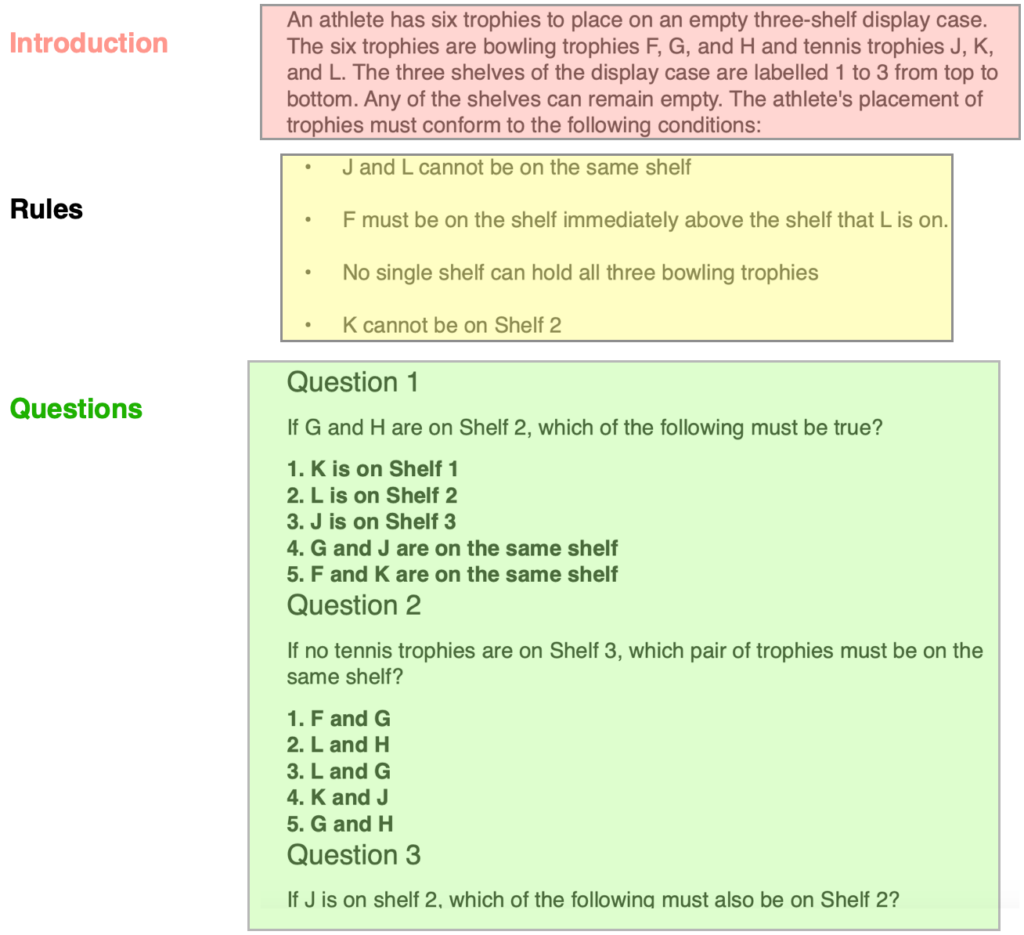
As with every section of the LSAT, some of the games are easier and some are harder. You’re going to want to prioritize and answer the easier questions first.
With practice, after reading the central setup you can make deductions to determine which type of question each one is. While you will be presented with four games on the LSAT, there’s a variety of different types of questions, all of which we will explore in this article.
Diagramming Is The Key Strategy To LSAT Logic Games
Diagramming is the key strategy to LSAT logic games! This is what you’re here to learn, and the reason so many students make vast improvements on their logic game scores. There is, indeed, a formula to dissecting the games — a method to the madness!
Using the example above, here’s how it works. The rules are going to give you the basis for making your diagram. But first, from the introduction, you’re going to want to get a list of entities. Entities are the things you’ll have to discern that are going to be moving around in the questions. In the example question, you can see that it is trophies.
Next, you’re going to want to find the frequency of how many times the entities are used. Finally, you’ll want to have placeholders; this is where the diagram starts to take shape. The placeholders are a set of lines that you’re going to put your entities into, along with the various categories in which they can be placed. In this case, it’s shelves. The more you do it, the easier it becomes. Really!
Types Of Logic Games
Now let’s look at the different types of games and how you can identify them.
Sequencing
Sequencing games are both the most common and the easiest to complete, so you might want to start by identifying a Sequencing game at the beginning of the Logic Games section to get some quick points and build confidence.
Sequencing games have just one set of entities that will need to be placed in order. In the example above, it’s trophies, but it can be anything – characters, actors, people, places or things that are going to be moving around in the game. Anything with a 1:1 ratio of variables to spaces is sequencing. For example, if there are 6 clowns doing 6 different tricks, it’s going to be sequencing. But, just to keep you on your toes, sometimes there will be an extra variable that will need to be assigned two spaces.
Diagramming Sequencing
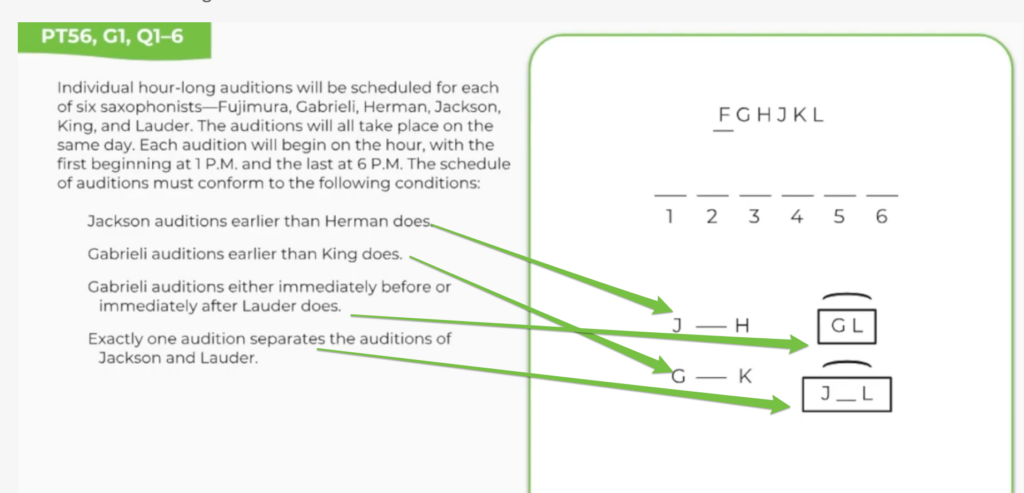
We can see the rules written out underneath the sequencing. For the sake of time and simplicity, in all logic games, you should assign letters for names and not write them out in their entirety.
Once you have the sequence and rules written out you can start to answer the questions. Here is an example of how using a diagram can help you answer the questions quickly.
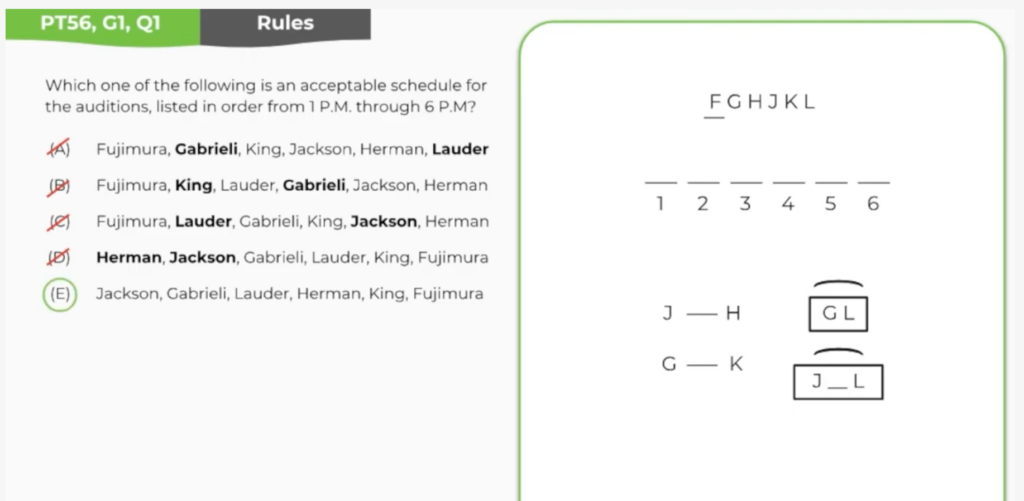
- G and L need to be consecutive
- G is always earlier than K
- J and L need to be separated by one
- J is always earlier than H
- Is the answer based on deduction
Matching
Matching games are less common, but do appear on the test so it’s a good idea to prepare for them. If you spot a Matching game, you might want to consider skipping this question and completing easier ones, and then coming back to it at the end.
Matching games will always have two different sets of variables, but don’t contain any ordered spaces. You’ll need to pair the variables with each other, but won’t be required to arrange them in a particular order.
Diagramming Matching
We can see the rules in the question below, but in this question we are adding inferences to the mix. These are what is known as if/then, only if, if and only if, or unless statements.
The main inference here is found in the third rule: “If she buys a vanity, she does not buy a footstool.” Since there’s only going to be one type of furniture that she doesn’t buy, it’s either going to have to be a vanity or a footstool. This allows us to complete two game boards – one where the footstool’s out, and one where the vanity is out. This means that every other type of furniture has to be in for both game boards.
So what else can we infer from the rules?
- If she buys a vanity, that means it’s maple
- If it’s not a sideboard, then it’s not made out of rosewood
- If she buys a footstool, she needs to buy a table made of the same type of wood.
- She can’t buy an oak table
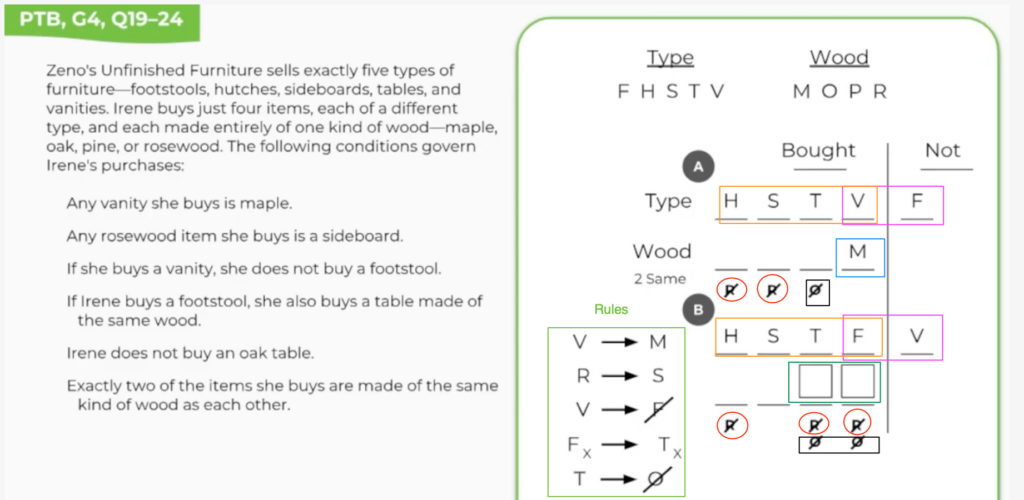
Now you can see why we recommend saving a Matching question (if you get it) until the end. Here is an example of a practice question:
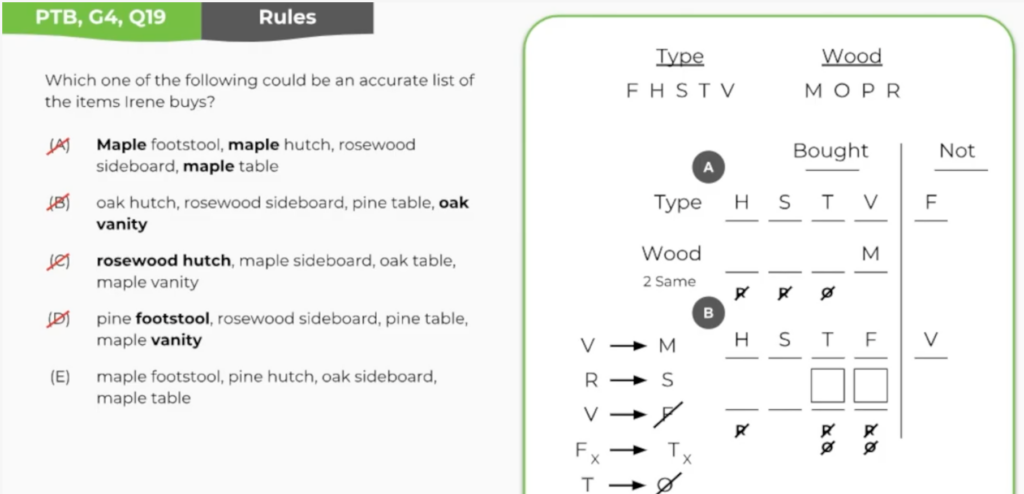
It is a good idea to deduct from the rules first and then move on to the inferences:
- She buys three items of the same type of wood, which is not allowed
- If she buys a vanity, it has to be a maple
- If she buys a rosewood item, it has to be a sideboard
- She can’t buy both a vanity and a footstool
- Is the answer based on deduction
Grouping
After Sequencing, Grouping games are the second most common games you will see on the test. The level of difficulty will vary, but the diagramming is fairly simple. This is another question you should try and do at the beginning of the Logic Games section to rack up as many points as possible, quickly.
Just like Sequencing games, Grouping games have only one set of entities, but they don’t have a 1:1 ratio of variables to available spaces. Rather, they provide you with two or three options where your variables can be placed.
Diagramming Grouping
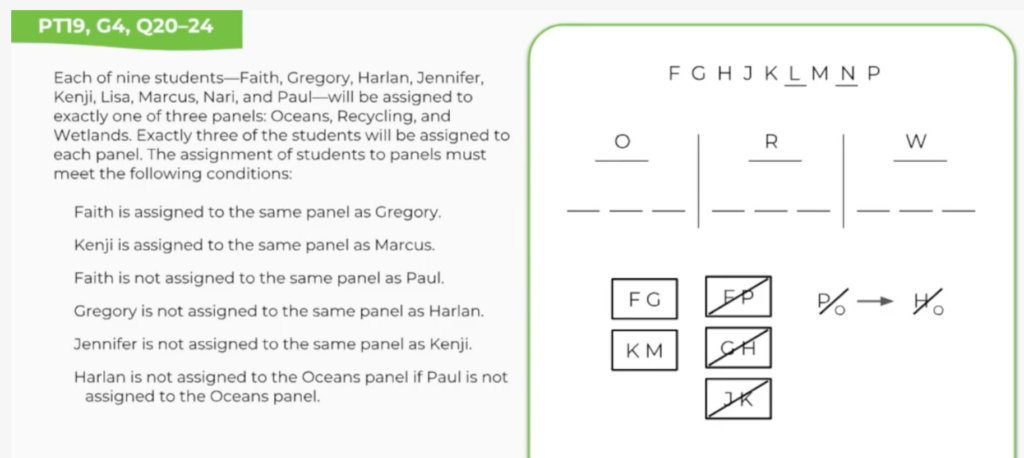
The reason L and N are underlined at the top is because they are “floaters,” meaning they aren’t involved in any of the rules. We want to draw our attention to those players as quickly as possible so that we don’t have to work through that roster of elements to try and figure out who has been placed, and who hasn’t. Instead, we want to identify the floaters fast so that we can remember them quickly and put them into the game board. There are also many inferences that can be made with this question, but too many too list, so we’re going to just stick with writing out the rules. For example, since F and G must be assigned to the same panel, and F and P cannot be assigned to the same panel, we can infer that G and P cannot be assigned to the same panel.
Practice question:
Here we are going to use the panel that we created by plugging M (Marcus) and P (Paul) into the Wetlands panel which is given in the question. If we look at the second rule, we can see that K and M have to be on the same panel, so we can plug K into the wetlands panel, as well. Next, we know that if P is not assigned to O, then H is not assigned to O so we can assign H to the R panel. And then since we know that G and H cannot be on the same panel, we must put G in the O panel. Finally, we can place F in the O panel because of the rule that F and G need to be on the same panel.
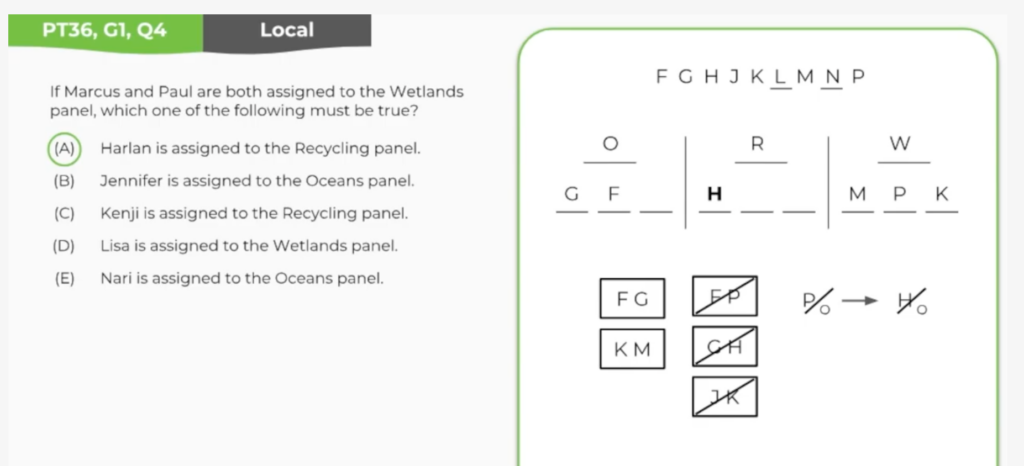
- We’ve assigned H to the R panel, given our inferences
- This could be the case, but it doesn’t have to be
- K is already assigned to the W panel
- There’s no room for L on the W panel
- We don’t know where N is going to go
Hybrid Games
Once you understand the basic Logic Games it is time to move on to Hybrid games, which involve combining two of the strategies referenced above into one game. These are relatively common games, which can vary by difficulty.
There are two different types of Hybrid games, sequencing/matching and grouping/sequencing. To spot a sequencing/matching game you’re going to be looking for two sets of variables that require you to place the variables in order. Grouping/sequencing games will have just one set of variables, but you’ll be asked to place the variables into groups, some of which might have internal order.
Diagramming Hybrid Games
Here we’re going to set up our game board complete with rules and then move on to inferences like we did with other questions, so let’s look at what they give us.
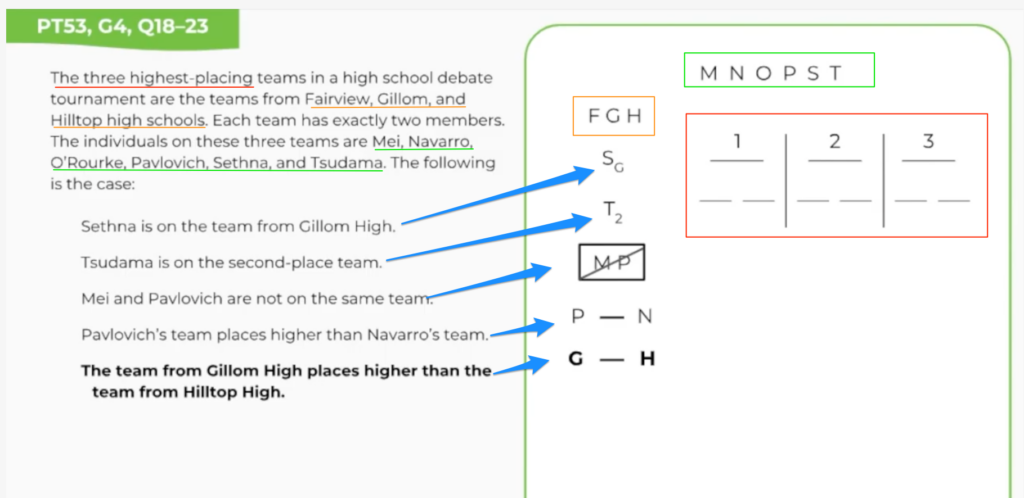
Now on to the inferences. Based on the last rule, we can first make three game boards. Next, we know that S is going to go into a G panel and T is going to be on the second place team.
We can’t tell anything from the next rule, but if we look at the fourth rule, we can see that P needs to go ahead of N, so on game A, since all the spaces on team G are taken, we can place P in the F team, and N in the H team. Now jumping back to the third rule, we know that M and P can’t be on the same team, so we can place M on the H team. This leaves only one open spot, where we can place O.
Given the rules, these are all the inferences we can make.
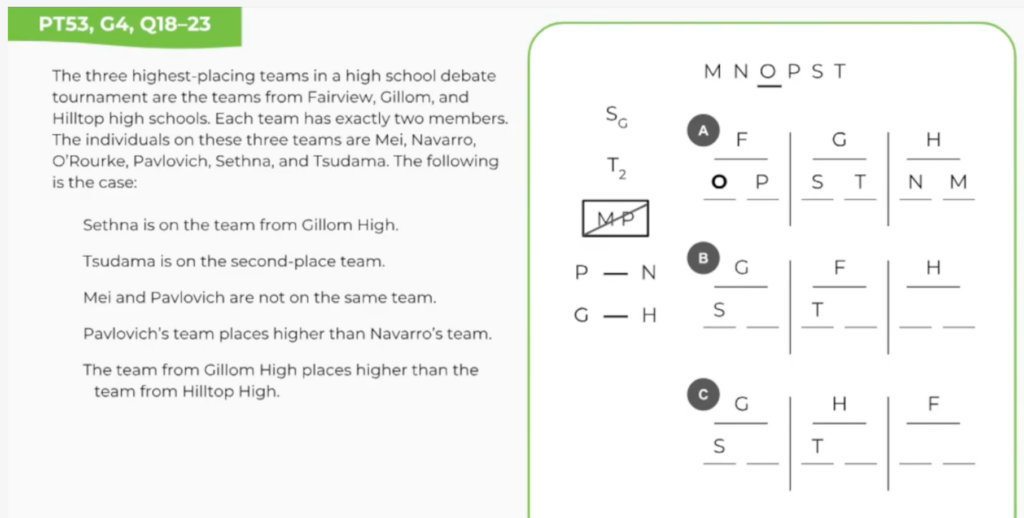
Practice question:
First of all, in frame A, P is not on the team from H, so we can leave frame A alone for this question. Next we can plug P into H on frames B and C. This takes team B out because of the rule that P needs to be ahead of N. Now on frame C we can place N on team F given that same rule that P needs to be ahead of N.
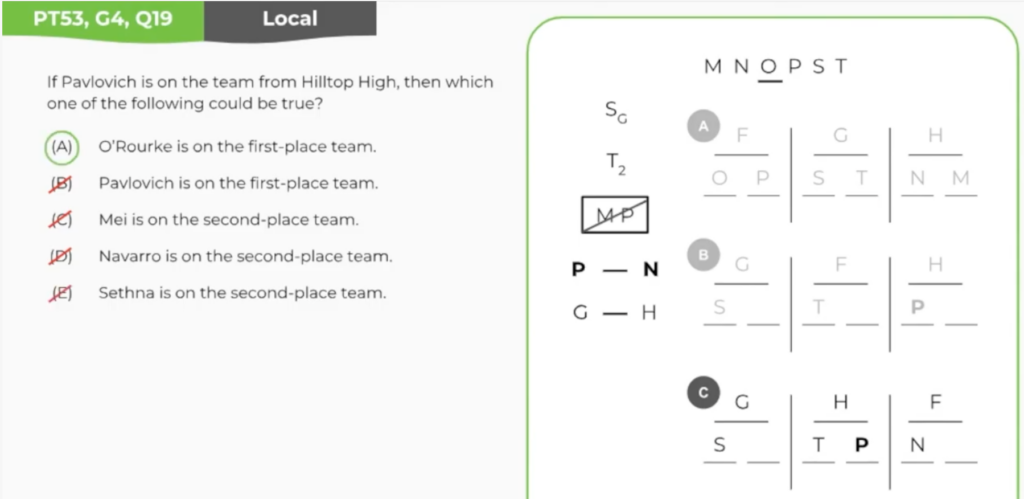
- This is possible, remember the question says could
- In our frame C, P is already on the second-place team
- The second-place team is already full, so M could not fit here
- We’ve already got N on the third-place team
- S is on the first place team because it needs to be assigned to frame G
Logic Games Strategy
Now you can see that there is, in fact, a method to the madness, and why the Logic Games portion of the test is where students make the most improvement. As with anything in life, practice makes perfect; the more you practice, the more comfortable you will be with answering these questions. The strategy you’re going to be using here is the same strategy you’re going to be using on the entire test, which is identifying the harder games to save for the end, and grabbing the easy points at the beginning.
Compare The Best LSAT Review Courses
Bryce Welker is an active speaker, blogger, and regular contributor to Forbes, Inc.com, and Business.com where he shares his knowledge to help others boost their careers. Bryce is the founder of more than 20 test prep websites that help students and professionals pass their certification exams.




